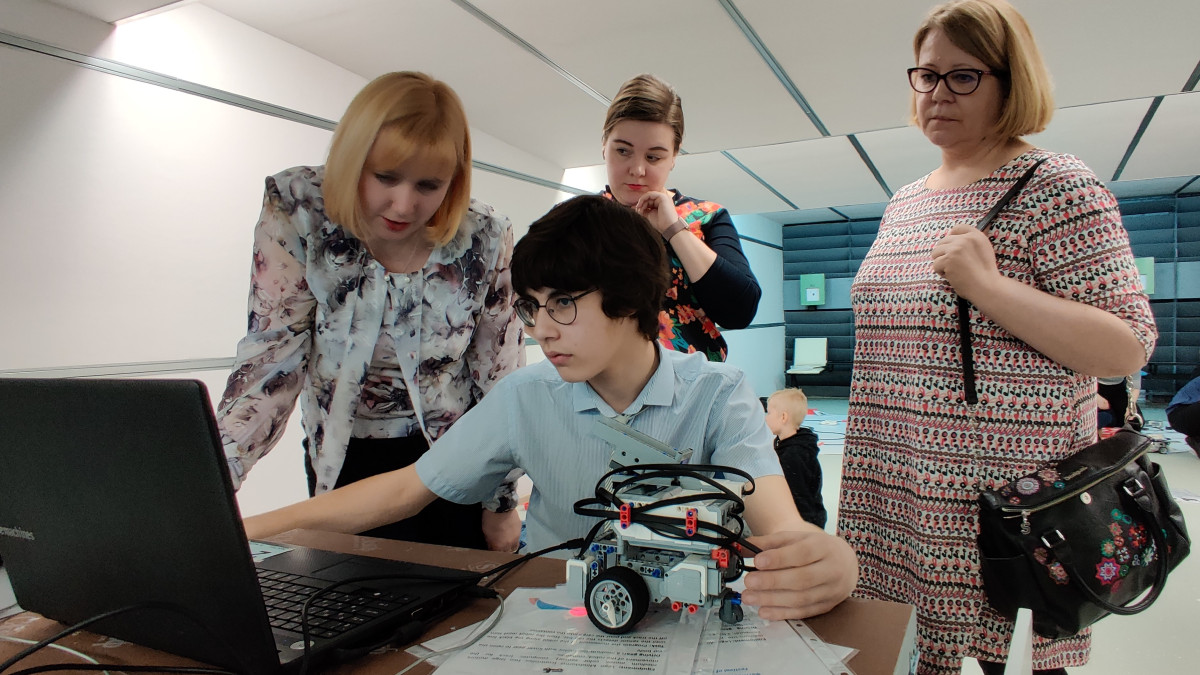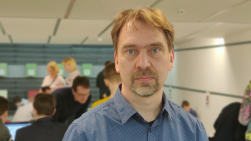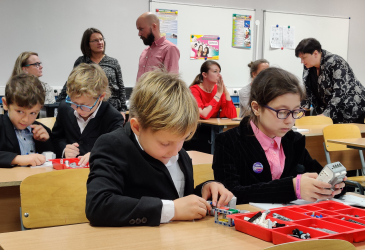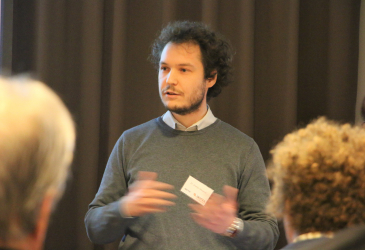

The Imatra schools break the limits of their competence with the St. Petersburg school
The trip of the robotics project is grateful to the teachers, because the students on the trip are interested and satisfied travelers. The 12 participating students either participate in a robotics club at their school or study robotics as an optional subject.
In St. Petersburg, you can stay comfortably in a hotel, because 80% of the trip's funding comes from the Nesttec EU project.
The program at school number 622, located in the northern part of St. Petersburg, is clear. On the first day, robots are assembled and programmed to perform the given tasks. The fact that assembly and programming is done in small Finnish-Russian groups brings its own challenge to work.
On the day of departure, the entire school of 1200 students goes by class to admire the impressively well-functioning robots. At this point, the relationship between the students from Imatra and St. Petersburg gradually begins to slip.
A master of two cultures
Sixth grade student at Mansikkala school Justus Tyyskä decided to try the after-school robotics club in the fall, when the teacher leading the club Yrjö Jouhki went to talk about it in class.
- When I visited once, it felt really nice. It wasn't even that terribly difficult. Now I have learned to build robots and program them, says Tyyskä, who had no previous experience in robotics.
Robotics is best learned by doing.
- When the Russians came to Imatra, I learned best when I got into the best group with one good player. It could program well though, so I learned quite a lot from it.
Germany's absolute trump card in Finnish-Russian cooperation is the Russian language skills learned through grandma.
- I have a friend from St. Petersburg and we have each other's phone numbers. I met him for the first time at Imatra (November 2019) and we were together yesterday at the same workplace.
In Germany, it's nice to have a Russian-speaking friend with whom you can practice your language skills. He hasn't particularly thought about his own future yet. Both robotics and the Russian language are still good hobbies.
Ivan Tshernishov aims for the field of technology
Robotics is also optional in school 622. A ninth grader Ivan Chernishov has been interested in physics and information technology since elementary school. The determined young man has tried various technical clubs and additional training.
- After school, I plan to apply to study physics, mathematics or information technology. The earlier you prepare for applying, the better. Getting into school is affected by everything, school grades, entrance exams and yo-test. Each university has its own criteria.
Ivan's school day is gathering pace.
- The clubs start after lessons at 15.45:XNUMX p.m. Then I stay in the robotics or physics club. It will be five or half past six. Sometimes I had time to eat at home when school ends earlier. For me, teaching is both a hobby and a way to get ahead, Tshernishov says.
Tshernishov is a good student who takes the role of the person in charge in his group that builds robots. However, the teacher is the authority.
- Of course, teachers know better. However, I usually do it differently than others. Sometimes it works and sometimes it doesn't, Tshernishov reflects.
In robotics, the teacher experiences a new challenge and sees the power of motivation
Working as a math teacher at Koske School in Imatra Minna Parjanne has been teaching math, physics and chemistry for 20 years now. Robots have been in Parjante's industry for a couple of years.
According to him, all students who join robotics learn at least the basics in the seventh grade.
- The robot must know how to make it move forward, turn and repeat the same function. You have to learn how to use the sensors and this is how you can follow the line on the carpet. After going through these, you can fulfill yourself, says Parjanne.
The teacher's role has changed and it has become concrete for Parjantee with the teaching of Robotics.
- Within a few years, a phenomenon has emerged that the teacher is no longer the "boss" in the same way as before. This is especially evident in robotics. A couple of third graders know some things better than me and I sometimes ask them how to do this? In the first year I tried to qualify, but now I don't even try, Parjanne laughs.
Robotics has also rewarded its teacher.
- It has never happened before like before Christmas, that I couldn't get students out of class, even though the class was on Fridays from two to three in the afternoon, Parjanne updates.
Next fall, robotics will be offered at Koske's school for eighth graders, and in the future also for ninth graders.
The Nesttec project makes it easier for teachers to prepare for teaching future courses not only by increasing their skills, but also by making it possible to acquire additional parts for the robots.
Same robots, different teaching processes
Thanks to Nesttec, Minna Parjanne has gotten to know colleagues from St. Petersburg. Mathematics and information technology teacher at School 622 Irina Gausin with the language barrier has been overcome by speaking through Google translator.
Robots are also new to Gaus, who moved to his current school last year. In connection with the robotics club that started in the fall, he took a method course for teaching robotics technology.
Gaus is fascinated by practicality in robotics.
- In robotics, I see how programming turns into concrete action. On the other hand, robots are not only used in "clubs", but in many practical jobs. It also motivates children. Robotics is in high demand at the moment. There will also be new fields where robotics are needed, says Gaus.
In the Nestec project, Gaus has not observed that there are cultural or personal differences in what students do.
- Each student is individual and understands and solves similar tasks in his own way.
Instead of the students' cultural differences, Gaus has drawn attention to the differences in teaching cultures.
- The differences in the study process were surprising. You have it organized in a completely different way. You have more freedom. We sit behind the teacher's desk. Not always, of course, but usually. I can't say which one is better. It depends on what you are used to, Gaus thinks.
Lego robots and competitive action
The Lego Group manufactures the Lego Mindstorms product line, from which you can build different robots. EV3 Home edition and Education series are currently on sale, with small differences in content. The Education package is intended for use by schools and is used from elementary school all the way to university.
In addition to the EV3 central unit, the Education package for school use includes a battery, 2 drive motors, 1 medium-sized motor, 2 touch sensors, a color and light sensor, an ultrasonic distance sensor and a Gyro position sensor. In addition to these, e.g. IR distance sensor and remote control as well as temperature sensor and energy meter.
The robot can be programmed in several different ways. The package comes with a graphical programming tool, which has its own versions for Android, Ipad and PC. Of these, the PC version is the most versatile and the Android version is the simplest. Programming can also be done using common programming languages, such as C, Forth, Java or Python, or with the LabView program. In this case, another firmware must be downloaded to the EV3 unit.
Various construction and programming tips can be found in abundance on the web.
In Finland, you can get support, for example From the Innokas network.
Internationally, the most extensive form of competition is FLL (First Lego League). Every year, Lego publishes a new task mat, the tasks of which the team must complete with the robot they have built. In 2019, there were more than 35000 participating teams worldwide. In Finland, FLL events are organized by the Robotics and Science Education Association www.fllsuomi.org. The task field can also be excellently applied in club activities and teaching.
International Lego robot competitions in various disciplines are also organized by Robotex.
The Nesttec project
New Stream of Technology (Nesttec) project duration is 1.10.2019 October 30.9.2022-XNUMX September XNUMX
Project budget €279, of which EU money €971 (223%)
The project has a total of eight workshop meetings or seminars, where students assemble robots and program their functions

Getting into robotics is worthwhile - talented people are being taken out of control
A person working as a development manager at Stora Enso was also on the trip Timo Lankinen, who coaches a team of three fifth-graders from Vuoksenniska school that was successful in the lego competition, where Timo's son Samuli Lankinen in addition, are Samu Lehikoinen ja Eino Berg.
Last week, the team won the Southeast Finland regional qualifiers of the robotics championships organized by Innokas ry and will continue in the national championships in May in Espoo.
Lankien's hobby of robotics is a joint affair between father and son. The hobby is a continuation of the construction of Legos, to which no less than 30 square meters of space in the family's home has been dedicated. According to Timo Lankinen, "enough" Legos have been purchased for them so that they can build with their own equipment. Gradually, the interest has led to competition.
- Robomasters was on TV. That's where the enthusiasm for competition started. Even now, they were watched before these games in the winter. A new version of Robomasters will be filmed this spring, Lankinen says.
Vuoksenniskai friends have built legos before in the upper floor of Lankinste and now also in the school's robotics club, which started in the fall of 2019.
Different robotics competitions and school robotics clubs use the same equipment, so the sport is very international. Competitors assemble the robots themselves from parts that include a central unit, motors and sensors, as well as plastic parts resembling more traditional engineering Legos. In addition to assembly, the competitor must program the robot to work according to the given tasks.
According to Lankinen, building Lego robots has exactly the same idea as industrial logic.
- The basic idea is the same. When you understand one, you understand the others. These differ from industrial robots in that there are many more commands and sensors in industry, which makes their operation more expandable. In Lego robots, processor power and connection points are limited, so it is simple enough and also suitable for children, Lankinen explains.
According to Lankinen, the knowledge of robotics is very useful in his work environment in industry.
- Robotics really meets the demand, because more robots have entered the industry and automation is increasing. New employees should more or less know these things. There is especially a shortage of robot and logic programmers. You can't find enough of them.
Understanding robotics isn't just for geeks.
- It is already useful in the factory. It is also good for the machine operator to know how robotics works. Jobs that require knowledge of robotics include, for example, electrical automation installer or its work management. Maintenance and shift workers must know automation and robotics. Robotics currently runs the entire industry. If there are no experts in this field, then it is a return to the 60s, Lankinen describes the importance of robotics.
Related to the topic

The Nesttec project strengthens robotics skills in schools
The joint project between Imatra and St. Petersburg school was kicked off in St. Petersburg on Wednesday.

"Robots will become members of society," predicts the researcher
Experts talked about the application of robotics and programming at the international seminar for schoolchildren at Holiday Club Saimaa. The audience was








